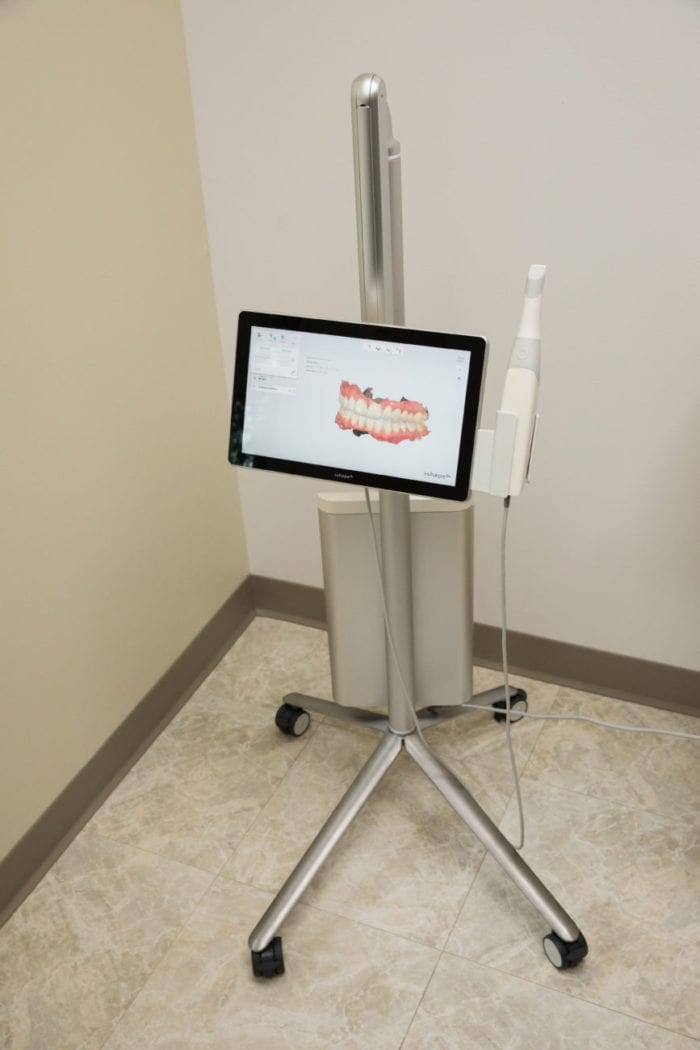Dr. Wooddell and Dr. Passaro have been early adopters of advanced digital technology for enhancing the diagnostic and treatment planning process. From digital x-rays and photography to cone beam CT (CBCT) scanning, high-resolution imagery can provide our team with detailed views and valuable information about the structure of your dentition. One of the other benefits of using this type of technology is that it is non invasive, pain free and can allow us to work with greater accuracy, reducing the need for additional treatments in some cases.
Technology Used In Our Office
We utilize five different software programs to analyze the data from cone beam CT scans, with each offering a slightly different distinction. The program we choose to use for a particular patient is dependent upon their unique needs. All the programs allow for visualization in three dimensions (regular radiographs are only two dimensional). We have encountered numerous situations where conventional radiographs have not revealed problems that were readily apparent in the cone beam CT image. With three of our programs, dental implants can be virtually placed in the software and surgical templates can be fabricated for ideal positioning of dental implants relative to the desired tooth position and bone. If you would like to stop by our office, we will be happy to show you our Kodak 9000 cone beam CT scanner and give you a demonstration.
Computer Guided Planning & Placement
We use CAD/CAM techniques in combination with precise models or temporaries to produce beautiful results that duplicate the natural teeth that have been lost.
With our Cone Beam CT technology, we can scan the jaw in just 19 seconds, allowing us to determine the amount of bone available for dental implants. From the scan, we create a 3D image that is dimensionally accurate. From this image we create a plan for the placement of your implant that includes surgical guides to ensure it is placed exactly where planned.
CT Scan/3D Imaging
In addition to digital x-rays for conventional dental x-rays, we are equipped with the Kodak 9000 extra-oral imaging system. This equipment allows us to provide high-quality digital panoramic x-rays as well as focused-field 3D images (cone beam CT scan).
The panoramic x-ray gives a broad view of the entire mouth. This x-ray supplies information about the teeth, upper and lower jawbone, sinuses, jaw joints, and other hard and soft tissues of the head and neck. The panoramic X-ray has many applications, including evaluating patients with past or present TMJ or jaw joint problems; those who require full or partial removable dentures, dental implants, or braces; those who are at risk or suspected of having oral cancer or other tumors of the jaw, have impacted teeth (especially wisdom teeth) or have had any recent trauma to the face or teeth (e.g., can help identify a fractured jaw); and for those who cannot tolerate other types of films (severe gaggers).
Intraoral Scanners
 Digital scanning is the new way forward in patient-first restorative dentistry. Not only is it a faster, easier process with more accurate results, it drastically reduces intraoral discomfort and helps provide the patient a better understanding of their treatment plan. Using an intraoral camera housed in a small wand, a digital impression of a patient’s mouth is obtained which we then use to generate options for treatment. The digital impression can be shared easily with the lab for case fabrication.
Digital scanning is the new way forward in patient-first restorative dentistry. Not only is it a faster, easier process with more accurate results, it drastically reduces intraoral discomfort and helps provide the patient a better understanding of their treatment plan. Using an intraoral camera housed in a small wand, a digital impression of a patient’s mouth is obtained which we then use to generate options for treatment. The digital impression can be shared easily with the lab for case fabrication.
We use both a 3Shape® and an iTero® intraoral scanner in our office to take impressions for our restorative and Invisalign® cases.
SprintRay 3D Dental Printer
In 2022, we acquired a 3D printer we primarily use to fabricate models and some occlusal appliances here in our office. To produce a model or appliance, we first collect a digital impression with an intraoral scanner. We then send the scans to a design station and import the digital scan into design software (CAD) and design the item. Once designing is complete, we import the file to print preparation software for setup and printing. 3D printing is improving the patient experience by allowing dental practices and labs to produce custom, high quality objects and appliances in a quicker and more cost-efficient way.